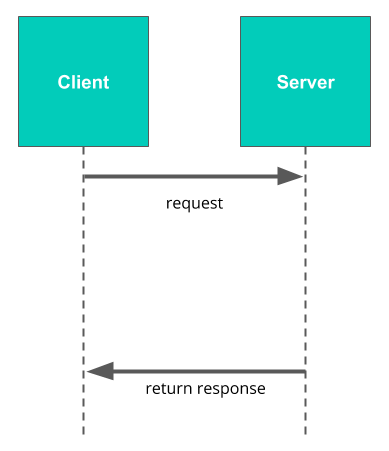06. Client-Server Model
Client-Server Model Heading
Client-Server Model
In order to build database-backed web applications, we first need to understand how servers, clients, and databases interact.
A major part of this is the client-server model , so let's look at that first. The basic idea is very simple, and looks something like this:

A server is a centralized program that communicates over a network (such as the Internet) to serve clients .
And a client is a program (like the web browser on your computer) that can request data from a server.
When you go to a web page in your browser, your browser (the client) makes a request to the server—which then returns the data for that page.
Adding databases to the model
So that's the basic client-server model. But when you add in databases, this creates a little more complexity.
In this next video, we'll review the basic model and then see how databases fit into things.
ND004 C01 L02 06 Client-Server Model
Client-Server Model Recap
In summary, relational database systems follow a client-server model :
Servers, Clients, Hosts
- In a Client-Server Model, a server serves many clients .
- Servers and clients are programs that run on hosts .
- Hosts are computers connected over a network (like the internet!).
Requests and Responses
- A client sends a request to the server
- The server's job is to fulfill the request with a response it sends back to the client.
- Requests and responses are served via a communication protocol , which sets up the expectations and rules for how the communication occurs between servers and clients.
Relational Database Clients
- A database client is any program that sends requests to a database
- In some cases, the database client is a web server! When your browser makes a request, the web server acts as a server (fulfilling that request), but when the web server requests data from the database, it is acting as a client to that database—and the database is the server (because it is fulfilling the request).
Don't let this confuse you. Basically, we call things clients when they are making a request and servers when they are fulfilling a request. Since a web server can do both, it sometimes acts as a server and sometimes acts as a client.
QUIZ QUESTION: :
Let's review the basic vocabulary we've covered. See if you can match each term with the correct description.
ANSWER CHOICES:
|
Description |
Term |
|---|---|
|
Client |
|
|
Server |
|
|
Communication protocol |
|
|
Host |
SOLUTION:
|
Description |
Term |
|---|---|
|
Client |
|
|
Server |
|
|
Communication protocol |
|
|
Host |
Client Quiz
SOLUTION:
Request to the serverServer Quiz
SOLUTION:
Response fulfilling a client's requestClient-Server
SOLUTION:
ClientClient-Server 2
SOLUTION:
ServerQUIZ QUESTION: :
See if you can fill in the blanks in the sentences below.
ANSWER CHOICES:
|
Sentence |
Client / Server / Host |
|---|---|
|
host |
|
|
server, server |
|
|
host |
|
|
server, client |
|
|
client, server |
SOLUTION:
|
Sentence |
Client / Server / Host |
|---|---|
|
host |
|
|
host |
|
|
server, server |
|
|
host |
|
|
host |
|
|
server, client |
|
|
client, server |